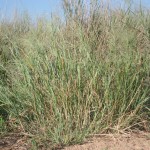Switchgrass
Panicum virgatum L.
Poaceae
Description
The hollow stems of this bunchgrass grow in clumps from many scaly, creeping rhizomes. These large, robust plants have green grass blades up to 2 ft or 60 cm long. Leaves turn yellow towards the fall season and become paler toward winter. The ligule is a dense ring or cup of hairs on the upper leaf surface at the collar. The panicles are pyramid-shaped, have many purplish spikelets, and are finely textured. Flowering occurs from August to November. The first glume is three-fourths as long as the spikelet and encircles the base of the second glume. In winter, the seed head resembles the branches of a weeping willow tree. Seeds are teardrop-shaped and measure about 1/8 inch or 3.2 mm long. Switchgrass is a perennial, warm-season, native species reaching 36 to 72 inches or 91 to 183 cm tall. Good grazing for livestock. Fair grazing for wildlife. Seeds may be consumed by ground-feeding bird species. It can also provide cover and nesting material. Switchgrass serves as a larval host for the Delaware Skipper and Dotted Skipper butterfly species.Habitat
Found mostly along creeks and streams, in protected areas, in pasturelands, and on roadsides where moisture is available. Decreases with heavy grazing. Switchgrass is a dominant species found in the tallgrass prairie habitat type. It is distributed from Canada to most of the United States and south to Mexico and Central America.Images
Plant Characteristics
Seed Type: Caryopsis
Duration: Perennial
Stem Texture: Hairless/Smooth
Growth Habit: Bunch grass, Grasses
Leaf Shape
 : Simple with Pinnate or Parallel Venation
: Simple with Pinnate or Parallel Venation
Season: Warm
Distribution
 : 01 - Pineywoods, 02 - Gulf Prairies and Marshes, 03 - Post Oak Savannah, 04 - Blackland Prairies, 05 - Cross Timbers and Prairies, 06 - South Texas Plains, 07 - Edwards Plateau, 08 - Rolling Plains, 09 - High Plains, 10 - Trans-Pecos
: 01 - Pineywoods, 02 - Gulf Prairies and Marshes, 03 - Post Oak Savannah, 04 - Blackland Prairies, 05 - Cross Timbers and Prairies, 06 - South Texas Plains, 07 - Edwards Plateau, 08 - Rolling Plains, 09 - High Plains, 10 - Trans-Pecos
Distributions
Distribution refers to the ecological region in Texas that a plant has been found. You can also view a clickable map.
Book: Know Your Grasses (B-182)
Collection: Grasses





